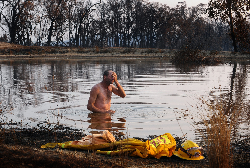Craig Borrow
Where have you worked and over what time period?
I started work as a cadet photographer at the Herald and Weekly Times in 1978, where I spent four years working mainly in the darkroom. Once or twice a week I was assigned to either the afternoon broadsheet, the Herald, or the morning tabloid, the Sun News Pictorial. In 1982 I was promoted to the position of ‘C’ grade photographer given a position on the Sun News Pictorial.
News Limited took over The Herald and Weekly Times and in 1990 the the Herald and the Sun News Pictorial were combined under one mast head; the Herald Sun.I was fortunate enough to have the first front page picture in this publication.
During my time at the Herald Sun I covered five Olympic Games, three Commonwealth Games, Davis Cup Tennis finals in France and Spain, the Hoddle Street massacre, the Ash Wednesday and Black Saturday bush fires, the Brisbane Floods and Kerang rail disaster.
I took a redundancy from the paper in 2012.
How did you get into press photography - what was your big break?
I became interested in photography in my mid-teens. I found it gave me a break from the pressures of school and exams. One night during a study break I went walking with my camera and photographed one of the first silver trains going through Springvale station. It wasn’t a particularly good shot, but I was lucky enough to win a prize in The Age School Photographic Competition. This awoke me to the possibility that photography was a career choice.
What is your favourite photograph of all those you have taken and why?
Perhaps my favourite photograph is of CFA volunteer, Warren Rees, who lost almost everything while fighting the Black Saturday fires at Strathewen. Warren's house was burnt to the ground and all his neighbours perished. He remained at the property, living in a shipping container and continuing with the CFA to help maintain fire lines and with the cleaning up.
Warren had no running water and would bathe in a dam near his property after returning from his day’s shift. When I took the shot, it was incredibly quiet. Everything was gone - even the birds.
What is the biggest change you've seen in press photography over your career?
Digital technology has brought the biggest change to press photography in my career. When I first started on the road, country news jobs were processed in a make shift darkroom. Negatives were developed and then prints made in the back of a ‘Mr Whippy’ style van. The photographer would then have to find the closest Post Master General to obtain a line at the back of a telephone exchange. Once a line back to the office was established, the print was placed on a drum scan and a light beam slowly scanned the photograph, turning it into a series of beeps. These beeps were converted into a negative back at the office, which then had to be processed and printed once more. Each step reduced the quality and so, by the time the picture made it to the paper, it was generally of quite poor quality. The time from taking a picture to delivering a print to the office would be measured in hours. With the advent of digital cameras and technology, this time lapse has turned into seconds.
What was the first camera you used and what camera do you use now?
My first camera was a Richo 500g range finder. When I first started work I was issued with a Mamiya twins lens reflex and Nikon F. I used Canon F’s for a number of years and finished my career in newspapers with the Nikon D3s.
